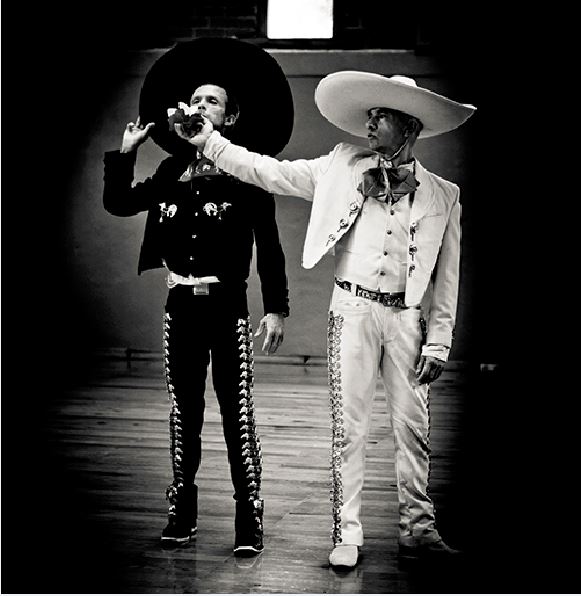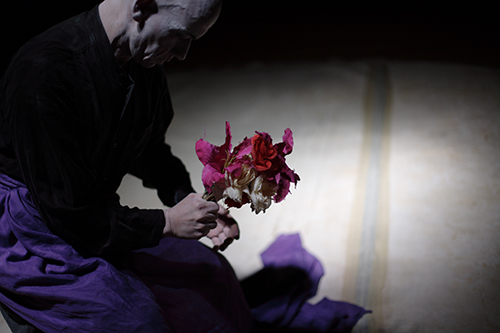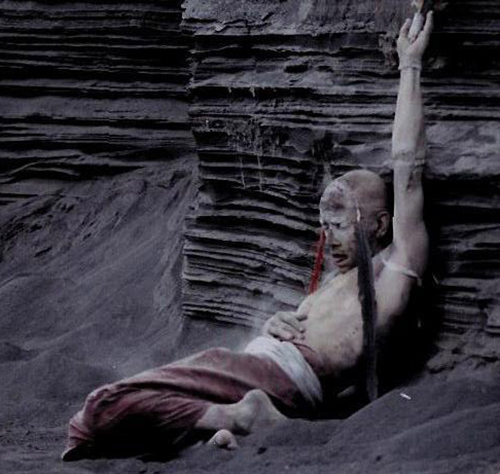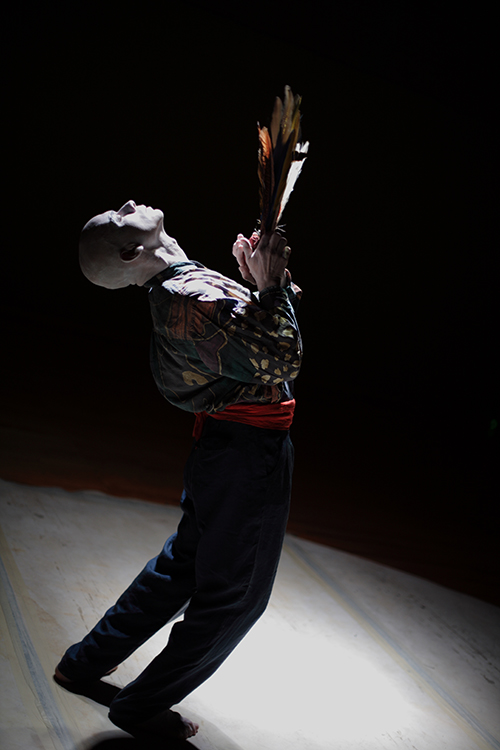Beyond Labels: Butoh Mexican Ritual
An Interview with Diego Pinon
BY EMMALY WIEDERHOLT
Diego Pinon is a Mexican Butoh artist and the founder of Butoh Mexican Ritual. He delves into the essence of ritual, diving beyond specific cultures to discover the common threads uniting human physicality and experience. Here, Diego describes his past and process, as well as proposes an understanding of dance beyond labels.
Photo by Rafael Perez
~~
How did you get into dance?
I believe I started dancing before I started walking. I have a very keen memory of my body expressing itself at any provocation. I spent my childhood in the mountains, 100 miles away from Mexico City. I remember how, always, music and stimulation provoked my body to move. I always danced.
In a formal way, I studied modern dance in Mexico City. I started with Graham technique. I studied social science at the university, but I always danced. I also swam and practiced gymnastics. But I cannot separate my experience learning Germanic traditions of dance with my experience of traditional Mexican dance. I am in the center of Mexico, where many wonderful ancient cultures are still alive through rituals.
When I reached the age of 17, I started working with a teacher to learn about body energy and bioenergetics. It was something completely different from any dance, yoga or therapeutic practice. This practice was very involved with the ancient groups who still practice their rituals. From studying the rituals and cosmic vision of the ancient peoples, I knew I could direct my creative energy in a very healing way.
When were you introduced to Butoh dance?
In the mid-80s, I saw a filmed interview with the Butoh troupe Sankai Juku. In the interview, they discussed dancing at one of the wonderful ancient sites in Mexico, the pyramids of Teotihuacan. They had done some sort of ritual there, and shared photographs from it during the interview. It was very attractive to me. I wondered why these dancers who were dressed in white and almost completely naked were dancing on top of the pyramids. But I connected to it. It was the first time I’d come across Butoh.
I immediately started researching more. I found Natsu Nakajima, the first Japanese female Butoh dancer to come to Mexico. She presented work in Mexico in 1987. Watching her was an ethereal and emotional experience. It was an internal experience that went beyond any visual or descriptive understanding; it was clear something was opening in my sensitivity. This started my deep research into Japanese Butoh.
What was the process of developing Butoh Mexican Ritual?
Kazuo Ohno came to Mexico two years after Natsu, in 1989. With him and Yoshito, his son, I had another powerful experience, although it was completely different than the one I had with Natsu. Kazuo Ohno was in his 80s, an old man, who channeled through his body the same ritualistic calling I had experienced in my childhood.
The traditions and rituals in Mexico are connected with the energy of nature. We can access the mystery of the natural and observe its benefits. Through Kazuo Ohno, I received a deep understanding of the power of the natural, how it already exists in every human body, no matter how big, beautiful, strong or fresh our bodies are. Our bodies can project, transmit, connect and touch other bodies and other sensitivities.
I researched Butoh more and more deeply, and had the chance to study in Japan. In 1996, I was invited to be part of a Butoh festival in San Francisco. The festival organizers asked me the name of what I did. With no pretensions, the only name that came to me was Butoh Mexicano. After some years of using that name, I decided to expand the formal name to Butoh Mexican Ritual and started a non-profit in Mexico City.
I never intended to be a model of Butoh or of the traditional dances of Mexico, but I feel I have a right to use the terms “Butoh,” “Mexican” and “ritual.” I don’t want to represent anything, but I want to use those terms as signs or symbols. Over the past 20 years, I have developed a process that integrates my roots and background in Mexico, my time studying, performing and teaching in Japan, the US and Europe, as well as my background in different forms of art, music, dance and theater.
How do you define the term “ritual?”
Ritual represents the condition of the human body to express deeply and transcend our surroundings. The essence of dance and ritual exists in every human body. It connects us to our ancestors, and yet we have the capacity to create new rituals.
The word “ritual” implies a way of paying a high level of attention, of being mindful and receptive, of listening and feeling our environment. We are the centerpiece of our own microcosms. Ritual is a tool, or a key, to reset our capacity to hold a global, holistic vision of our evolution as human beings.
Ritual belongs to every human being, because we develop our cultures through rituals, everywhere on the planet.
How do you define the “Butoh” part of your practice?
I always talk about the metaphor of building bridges, of connecting two different realities. When people ask if my practice is Japanese or Mexican, I cannot answer. I see us as universal beings who belong everywhere. I acknowledge my roots in Mexico, but I also acknowledge my learning from abroad. I have had the privilege of working with many people in the states and elsewhere, exchanging energy and ideas.
I don’t want to reinforce the myth of purely Japanese Butoh. For me, Butoh should be used as a tool for any kind of artist to connect deeply with primitive, soulful expression. Ancient cultures from centuries ago essentially practiced Butoh, painting their bodies with ashes and dancing with the natural. I am interested in universality, of connecting beyond borders. Dance is a sacred practice to heal ourselves and create a collective calling beyond myths and religions.
When, in your opinion, does cultural appropriation become problematic?
Every culture deserves respect. For that reason, I use the term Mexican, which I feel I have a right to, not Toltec, nor Mayan, nor Aztec, which refer to specific indigenous people who have their own histories. At the same time, I believe everything belongs to everyone. It’s a very delicate issue. I reserve my right to distill essential principles from ancient cultures. I believe everyone has that right, but it also demands respect for particular ceremonies or territories. It’s good to respect, but it’s also good to integrate.
How do you see your dance practice continuing to evolve?
Fortunately, my body is still in good dancing condition. However, when I saw Kazuo Ohno’s body dance, I couldn’t believe it’s beauty. While there are all these ideas about beautiful bodies full of energy, shape and muscles, I believe all bodies are mesmerizing. An old woman can still succinctly express herself. I am turning 60, and my body is still available to dance, but the dance is becoming more and more simple.
I believe more and more in teaching workshops. I present every workshop as a ritual. We create a collective and individual series of rituals, ending in performance. I believe it’s so important to perform, to give an artistic offering. If we receive, we need to give. Sometimes we dance in front of people in a public square, but sometimes we dance in front of a tree. The model of performance where the artist is on the stage and the people sit and watch is not something I believe in anymore. I have moved further and further from the image of butoh as an aesthetic form. I am not interested in any artistic model that reinforces the pretentious side of the ego. I am interested only to be in service to the creative and energetic forces that we all have the potential to open and share. Through collectiveness and energetic exchange, we can create our new and relevant rituals. I am now using Body Ritual Movement to describe this process. I hope to open new doors to serve anyone who has the impulse to open their bodies and spirits.
Any other thoughts?
I don’t believe in labels. Instead, I carry lineage. Lineage is ideas. We need to receive energetic exchange. This is the way I keep going, by offering workshops and performances in community.





3 Responses to “Beyond Labels: Butoh Mexican Ritual”
Ahh Diego.. so beautifully articulated. Intimate revelations, universal longings. Big love to you always!
Very evocative and thought provoking work by Diego Piñon. Thank you for this excellent article.
i enjoyed this article. I miss you Diego.
Comments are closed.